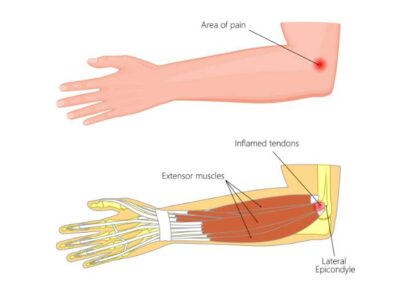Lateral Epicondylitis (Tennis Elbow) Specialist

Are you an athlete who participates in tennis, racquet sports or activities requiring repetitive motions? If so, you are at an elevated risk of developing tennis elbow. Tennis elbow is characterized by small tears in the tendon from continuous overuse of the arm and forearm muscles, leading to pain and tenderness on the outside of the elbow. Tennis elbow specialist, Doctor Riley J. Williams provides diagnosis and both surgical and nonsurgical treatment options for patients in Manhattan, Brooklyn, New York City and surrounding areas who have symptoms of tennis elbow. Contact Dr. Williams’ team today!
What is lateral epicondylitis?
Lateral epicondylitis is more commonly known as tennis elbow. Lateral epicondylitis is characterized by inflammation of the tendons that secure the muscle in the forearm to the outer side of the elbow (extensor carpi radialis brevis). Lateral epicondylitis causes pain and tenderness on the outer side of the elbow. Sports, such as tennis, or other activities where the elbow, wrist, or hand is overused, are common causes of tennis elbow. The tendonitis and tendon injury that is associated with lateral epicondylitis causes pain and difficulties with wrist and hand extension.
CLICK IMAGE TO ENLARGE
Lateral Epicondylitis (Tennis Elbow)
What is an extensor capri radialis brevis tendon tear?
The extensor capri radialis brevis (ECRB) tendon is the tendon, or fibrous tissues, usually associated with tennis elbow. This muscle is located on the lateral (outside) of the elbow. Outer forearm tendons are often called extensors. The ECRB tendon attaches muscle to bone within the forearm, and to the upper arm bone, or humerus. The ECRB muscle is responsible for stabilizing the wrist when the elbow is straight. Small tears from overuse can form in the ECRB tendon if the muscle is subjected to repetitive overuse. Dr. Riley J. Williams, orthopedic elbow specialist, serving Manhattan, Brooklyn, New York City, NY and surrounding areas, has extensive experience in treating lateral epicondylitis, an extensor capri radialis brevis tendon tear, and other complex elbow injuries.
What are the symptoms of lateral epicondylitis?
The onset of tennis elbow symptoms typically happens gradually over the course of weeks or months. A specific event or injury may also precede the onset of tennis elbow symptoms. Use of the arm in vigorous sports and activities may increase pain symptoms. Individuals in the New York area who experience this type of injury often report the following symptoms:
- Pain at the outer elbow
- Weakened strength while gripping
- Weakness of wrist and hand extension
- Burning sensation on the lateral (outside) of the elbow
How is lateral epicondylitis diagnosed?
Dr. Williams will ask questions regarding your history and activity level. It is important to discuss with the doctor whether or not there are associated injuries with the elbow, such as arthritis or nerve disease. Dr. Williams will perform a physical examination to pinpoint where the pain is located. Imaging tests such as x-rays, an MRI or an EMG may be ordered to detect lateral epicondylitis along with other issues such as arthritis or nerve damage. An MRI will provide Dr. Williams with images of the damaged muscles and tendons.
How is lateral epicondylitis treated?
Non-surgical treatment:
Most individuals have success with non-surgical treatment. Conservative methods can include: medication, rest, physical therapy, bracing the elbow, shockwave therapy, platelet rich plasma (PRP) injections, or corticosteroid injections. NSAIDs (non-steroidal anti-inflammatories) such as ibuprofen, can reduce pain and inflammation during flare-ups. Resting and reducing activity for several weeks can also help alleviate symptoms. Dr. Williams may order physical therapy for strength training purposes. Dr. Williams may also discuss the most appropriate treatment for your specific elbow injury.
Surgical treatment:
Surgical treatment may be recommended if symptoms do not improve after approximately 6 months of conservative methods. Surgery may involve removing diseased tendon and reattaching healthy tendon back to the bone. The procedure is typically outpatient, and does not involve an overnight stay in the hospital. Dr. Williams will discuss the type of surgical method he will use and it is based upon the specific type of elbow injury, age, health and underlying medical conditions. Typically a full recovery is achieved in 3-6 months.
For more information on tennis elbow, a lateral epicondylitis, an extensor capri radialis brevis tendon tear and the treatment options available, please contact the office of Riley J. Williams, MD, orthopedic elbow specialist serving Manhattan, Brooklyn, New York City, NY and surrounding areas.
Locations
610 W 58th Street
New York, NY 10019
148 39th Street, 7th Floor
Brooklyn, NY 11232




